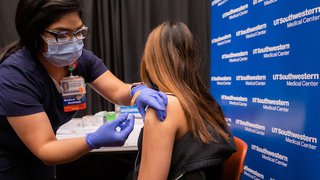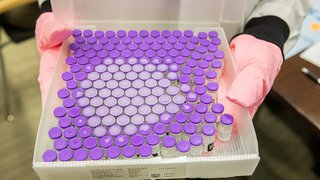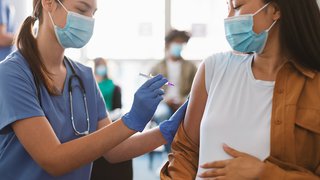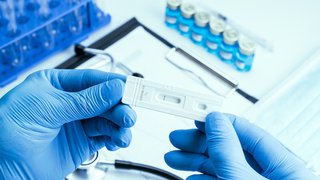
In the summer of COVID-19, days melt into months and it can seem as if the dark clouds hanging overhead will never lift.
But there are some rays of hope out there.
On July 14, The Washington Post published an op-ed by Joseph Allen, D.Sc., director of the Healthy Buildings program at Harvard, reminded us of several reasons for optimism amid the ongoing pandemic.
His article inspired me, and I wanted to add to his thoughts and tailor them for North Texans. So, here are seven positive signs we can all point to during the long summer of COVID-19.
1. COVID-19's rate of increase is slowing in DFW

UT Southwestern’s COVID-19 forecasting model, which has been extremely accurate in tracking and predicting the spread of the virus, indicates that the steady rise in hospitalizations in DFW is beginning to level off. According to the July 16 update, hospitalizations increased by only 3% from the previous week. That’s compared to a 124% increase from a month ago.
Mobility data also show DFW residents are staying closer to home and away from nonessential businesses since late June. These numbers show that the more effective we are at following mitigation measures (wearing masks, physical distancing, washing hands, avoiding large gatherings) the closer we’ll get to flattening the curve. Our collective efforts are currently 61% effective, according to the model. If we move the needle to 68% effective, we could begin to see a sharp decline in total number of COVID-19 cases.
In fact, Dallas County on July 22 reported its confirmed daily number of cases dropped below 1,000 for the first time in more than two weeks, with 734 cases. There is still a long way to go and it will take a sustained effort by all of us to limit community spread of COVID-19.
2. Masks are having a moment
On Monday, Walmart, the nation’s largest retailer, began requiring shoppers to wear masks in all of their 5,000+ stores. Kohl’s and Kroger also announced mask requirements recently, joining Starbucks, Target, Walgreens, and CVS, among others. More than half of the states in the U.S., including Texas, have issued orders requiring face coverings in public. On July 22, President Trump encouraged people to: “Get a mask. Whether you like the mask or not, they have an impact. They will have an effect and we need everything we can get.”
COVID-19 is a respiratory infection that needs access to our airways to flourish. Research has shown wearing a mask properly is one of the most effective ways to reduce the spread.

3. Vaccines are making progress
A COVID-19 vaccine developed by the University of Oxford has proven safe and effective in Phase 1 and 2 clinical trials, according to a study published in The Lancet. The trials had more than 1,000 human participants and showed that the vaccine triggered immune responses with minimal side effects.
The vaccine now must prove its effectiveness in Phase 3 human trials with about 50,000 participants. There are also 24 more COVID-19 vaccines in human clinical trials, including several that are close to Phase 3 testing, according to the World Health Organization (WHO). An additional 140 vaccines are also in development.

4. Testing is becoming more accessible
On July 22, Tarrant County launched a pilot program offering free COVID-19 saliva tests. Plans are to test 300 people a day at the outset and increase quickly from there. Saliva tests are easier to administer – patients spit into a test tube as opposed to needing a nasal swab. They also provide faster results, but saliva tests are considered slightly less effective with a 1% to 2% false positive rate.
Dallas County is continuing to add COVID-19 testing sites and reduce waiting times for results. On July 21, officials said they are considering a saliva testing plan. UT Southwestern is validating saliva tests and could use them in certain situations as well. Harvard’s Allen suggests that, with some refinements, saliva tests could be a low-cost solution to providing quick answers – like a home pregnancy test for COVID-19.

5. More therapies are working
More than 510 drugs are in development, and more than 230 trials of potential therapies have been reviewed under the FDA’s Coronavirus Therapy Acceleration Program (CTAP). UT Southwestern has been at the forefront of treating patients who are seriously ill with COVID-19 with the antiviral medication remdesivir and convalescent plasma, which is rich in antibodies. Both are given intravenously and have proven somewhat effective at speeding recovery of hospitalized COVID-19 patients. (Clinical trials have begun on an inhaled form of remdesivir.)
Several clinical trials of monoclonal antibodies to fight COVID-19 are also underway. The scientifically engineered antibody clones have the potential to treat or prevent the infection by posing as an imposter S protein – the spikes on the coronavirus “crown” that enable it to invade healthy cells and multiply.
6. Research efforts are moving at warp speed
The entire global scientific community is focused on solving the COVID-19 conundrum. That includes more than 180 investigational studies, biomedical research, and clinical trials at UT Southwestern. One clinical trial that just got underway is investigating whether atovaquone, a pill already approved by the FDA to treat some forms of pneumonia, will be effective in fighting COVID-19 infections.
The U.S. Department of Health and Human Services has created Operation Warp Speed to fast-track promising vaccines and therapeutic research in hopes of delivering solutions to the pandemic as quickly as possible while also balancing speed with safety.
Tracking COVID-19: How to help a community-wide effort
UT Southwestern’s Dr. Amit Singal and Dr. Jasmin Tiro are leading the DFW COVID-19 Prevalence Study, which will enroll 45,000 residents from Dallas and Tarrant counties. They joined Dr. John Warner to discuss how the data could have a significant impact on the community and how it can help contain COVID-19.
7. Study will measure the impact in DFW
One of the most difficult challenges to containing the spread of COVID-19 is the shortage of information about where it is spreading and why certain populations are affected more than others. To gain a better picture of the unfolding pandemic in Dallas and Tarrant counties, researchers at UT Southwestern and Texas Health Resources have partnered on one of the nation’s largest studies on community prevalence of COVID-19.
We will test 45,000 people representing all racial, ethnic, and socioeconomic groups in the region to collect data that may help uncover lifesaving treatments and stop future pandemics.
Final thoughts: Look for the bright spots
Nearly five months into the COVID-19 pandemic, it’s clear that we still have many difficult days ahead. Most importantly, we can’t relax any of our mitigation efforts or, as we’ve already seen, this virus will spread like wildfire.
So just as you would put on a pair of socks and shoes to protect your feet before you leave the house, grab your mask and get in the habit of wearing it. You’re protecting yourself and others. Also develop cues to remind yourself to keep washing your hands regularly. And don’t feel awkward about asking friends or strangers to keep a safe physical distance.
It’s also important to look for the bright spots in our everyday lives and try to return to some sense of normalcy. Recently, I attended my teenage daughter’s performance of a musical with the North Texas Performing Arts Group, and it was joyful. She wore a mask onstage, the limited number of patrons in the audience were spaced out more than six feet, and they all wore masks. The cast even put on their costumes at home to decrease time spent backstage. The performance was also live streamed.
Over the next few weeks, sports fans can look forward to the televised return of professional baseball (July 23), basketball (July 30), and hockey (Aug. 1), albeit without spectators. And school officials are also working hard to develop plans to return to virtual and safe in-person learning.
The truth is, we can live our lives and still limit many of the risks associated with the pandemic. But we have to keep working together to tame the COVID-19 beast.
For regular updates on UT Southwestern's response to the COVID-19 pandemic, please visit utswmed.org/covid-19.












